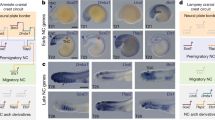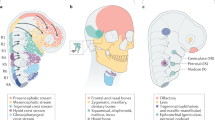Abstract
THERE is in birds a thin vertical plate of bone between the eyes known as the interorbital septum. In the chick embryo this originates from the fusion of two pairs of cartilaginous primordia (the orbital cartilages above and the trabeculæ cranii below) with each other and with a median cartilaginous bar, the intertrabecula. At around seven to eight days of incubation, these structures lose their identities and merge into one another to form the high thin septum of the fully formed chondrocranium. At about the same time the lateral unfused parts of the anterior orbital cartilages regress and disappear almost completely.
This is a preview of subscription content, access via your institution
Access options
Subscribe to this journal
Receive 51 print issues and online access
$199.00 per year
only $3.90 per issue
Buy this article
- Purchase on Springer Link
- Instant access to full article PDF
Prices may be subject to local taxes which are calculated during checkout
Similar content being viewed by others
References
de Beer, G. R., “The Development of the Vertebrate Skull” (Oxford, 1937).
Weiss, P., and Amprino, R., Growth, 4, 245 (1940).
Amprino, R., Acta Anat., 10, 38 (1950); J. Exp. Zool., 118, 71 (1951).
Author information
Authors and Affiliations
Rights and permissions
About this article
Cite this article
BELLAIRS, A. Skull Development in Chick Embryos after Ablation of One Eye. Nature 176, 658–659 (1955). https://doi.org/10.1038/176658a0
Issue Date:
DOI: https://doi.org/10.1038/176658a0
This article is cited by
-
Bau und Kerngr�sse des Tectum opticum vonGallus domesticus L. bei Angeborener Einseitiger Mikrophthalmie und Anophthalmie
Wilhelm Roux' Archiv f�r Entwicklungsmechanik der Organismen (1957)
Comments
By submitting a comment you agree to abide by our Terms and Community Guidelines. If you find something abusive or that does not comply with our terms or guidelines please flag it as inappropriate.



